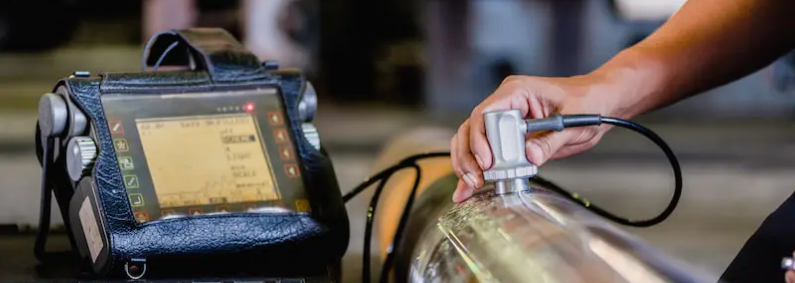
At Riyaarth Overseas, we prioritize testing as a core element of our quality assurance framework. Our comprehensive testing procedures ensure that every pipe meets international standards for performance, safety, and durability. From hydrostatic testing to advanced non-destructive testing (NDT) methods, our processes validate the mechanical strength, internal integrity, and operational reliability of pipes used across diverse industries.
Key Pipe Testing Methods
Hydrostatic Testing
| Aspect | Details | Key Steps |
|---|---|---|
| Purpose | Verifies pressure containment capability and detects leaks in pipelines. | 1. Develop testing plan and clean pipeline. 2. Isolate test section. 3. Fill pipeline with water. 4. Vent air from the system. 5. Gradually pressurize pipeline. 6. Monitor pressure and inspect for leaks. 7. Depressurize gradually. 8. Perform final inspection and document results. |
| Test Pressure | Typically 1.25–1.5 times the operating pressure, as per ASME B31.3 standards. | 1. Calculate test pressure based on design and material specs. 2. Adjust for elevation differences. 3. Ensure hoop stress does not exceed 90% SMYS. |
| Preparation | Cleaning pipelines, isolating sections, ensuring equipment readiness. | 1. Clean pipeline to remove debris. 2. Install blind discs or isolation valves. 3. Inspect and calibrate gauges and pumps. 4. Perform visual inspection of pipe and welds. |
| Monitoring | Continuous observation during testing to detect deviations or leaks. | 1. Apply pressure in stages: 50%, 75%, 100%. 2. Record pressure data continuously. 3. Visually inspect for leaks or deformation. 4. Maintain pressure for specified duration. |
| Post-Test Activities | Controlled depressurization, documentation of results, and rectification of leaks if needed. | 1. Gradually release pressure in controlled steps. 2. Drain water from pipeline. 3. Conduct final visual inspection. 4. Remove blind discs and restore pipeline. 5. Record anomalies and corrective actions. |
- Advantages:
- Simulates real-world operating conditions.
- Provides assurance of pressure containment capability.
Non-Destructive Testing (NDT)
NDT Method | Purpose | Process/Steps | Applications |
Ultrasonic Testing (UT) | Detects internal flaws using high-frequency sound waves. | 1. Transmit sound waves into the material. | Wall thickness measurement, locating internal defects in pipelines. |
Radiographic Testing (RT) | Examines welds and internal structures using X-rays or gamma rays. | 1. Position radiographic equipment around the pipe. | Weld inspection, volume flaw detection in high-pressure systems. |
Magnetic Particle Testing (MT) | Detects surface discontinuities in ferromagnetic materials using magnetic fields. | 1. Apply a magnetic field to the material. | Crack detection in welded joints and fittings used in construction frameworks. |
Eddy Current Testing (ECT) | Identifies surface and subsurface flaws using electromagnetic induction. | 1. Induce electromagnetic currents using probes. | Non-ferrous material inspections like stainless steel pipes in chemical plants. |
Dye Penetrant Testing (DPT) | Reveals surface-breaking defects using liquid dye on non-porous surfaces. | 1. Apply dye to the surface of the material. | Surface defect detection in pipelines used in oil & gas or water treatment systems. |
Applications Across Industries
|
Industry |
Importance of Testing |
|
Oil & Gas |
Verifies pipe integrity under high-pressure transport of fluids and gases. |
|
Construction |
Ensures structural safety for building frameworks and support systems. |
|
Chemical Processing |
Confirms resistance to corrosive chemicals and thermal stress. |
|
Water Treatment |
Validates hygiene, leak-proof design, and mechanical endurance. |
|
Power Generation |
Assures heat and pressure resistance in boilers, condensers, and turbines. |
|
Marine & Offshore |
Verifies anti-corrosion and pressure performance in harsh marine environments. |
|
HVAC & Fire Protection |
Ensures leak-proof function and pressure tolerance for emergency systems. |
|
Pharmaceutical & Food |
Confirms hygienic, defect-free surfaces in high-purity processing lines. |
Benefits of Comprehensive Testing
- Operational Safety: Prevents failures during use in critical environments.
- Regulatory Compliance: Meets requirements for API, ASTM, ASME, and ISO standards.
- Reduced Risk: Identifies flaws before product dispatch, reducing liability.
- Customer Assurance: Demonstrates commitment to quality and reliability.
Packaging & Delivery Assurance
- Pipes are carefully packed to avoid surface damage and contamination after testing.
- End caps, protective films, and wooden crates are used based on application and export requirements.
For thoroughly tested and certified pipe products, contact Riyaarth Overseas and let us help you ensure quality, safety, and compliance for your next project.
FAQ's
Hydrostatic testing checks pressure retention using water, while NDT evaluates integrity through methods that don’t alter or damage the material.
We conduct various NDT methods, including ultrasonic testing, radiographic inspection, and eddy current testing, to ensure defect-free and high-quality pipes.
Yes, all pipes undergo mandatory testing procedures based on customer and industry specifications.

Products
Industry We Serve
- Oil & Gas industries
- Chemical process industries
- Pump and valve in high pressure component
- Food industries
- Pulp and paper industry
- Aerospace industry
- Power plant
- Mechanical component
- Sugar industry
- Cement industry
